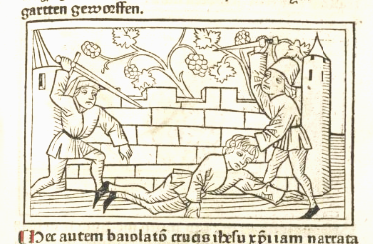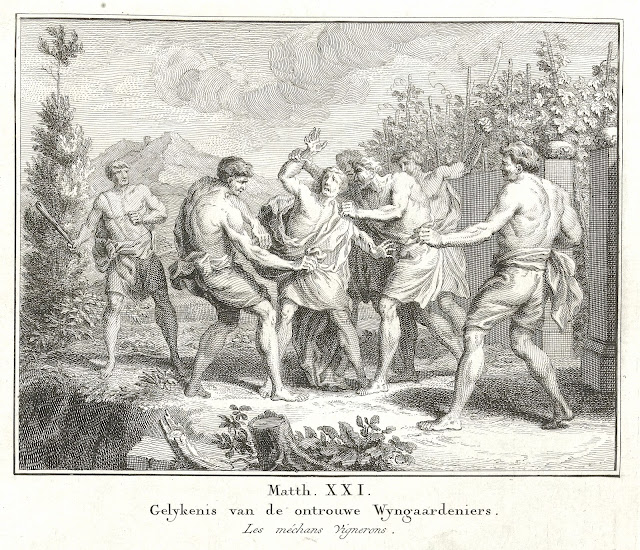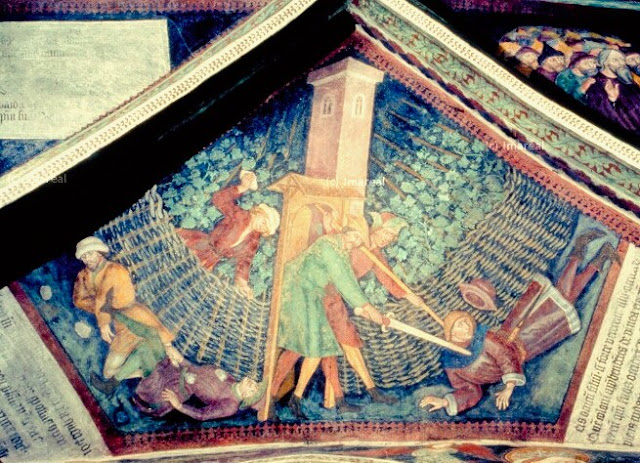 |
| The Parable of the Murderous Tenants From a Speculum humane salvationis German, c. 1350 Karlsruhe, Badische Landesbibliothek MS Karlsruhe 3378, fol. 69r |
“Jesus said to the chief
priests and the elders of the people:
"Hear another parable.
There was a landowner who planted a vineyard,
put a hedge around it, dug a wine press in it,
and built a tower.
Then he leased it to tenants and went on a
journey.
When vintage time drew near,
he sent his servants to the tenants to obtain
his produce.
But the tenants seized the servants and one they
beat,
another they killed, and a third they stoned.
Again he sent other servants, more numerous than
the first ones,
but they treated them in the same way.
Finally, he sent his son to them, thinking,
'They will respect my son.'
But when the tenants saw the son, they said to
one another,
'This is the heir.
Come, let us kill him and acquire his
inheritance.'
They seized him, threw
him out of the vineyard, and killed him.
What will the owner of the vineyard do to those
tenants when he comes?"
They answered him,
"He will put those wretched men to a
wretched death
and lease his vineyard to other tenants
who will give him the produce at the proper
times."
Jesus said to them, "Did you never read in
the Scriptures:
The stone that the builders
rejected
has become the cornerstone;
by the Lord has this been done,
and it is wonderful in our
eyes?
Therefore, I say to you,
the kingdom of God will be taken away from you
and given to a people that will produce its
fruit."
Matthew 21:33-43 (Gospel for the
Twenty-seventh Sunday in Ordinary Time)
The parables of Jesus tell us a great
deal about God, as well as a great deal about how we are to interact with other
humans. We all know the stories of the
Prodigal Son* and the Good Samaritan*.
Indeed, these two parable stories have become so well-known that they
are instantly associated with certain behaviors. But the focus of most parables is not so much
on the human actions, but on the light that they shine on the nature of God,
especially on his mercy and forbearance, qualities that we can easily relate
to. But not all parables are like
that. The parable in this Gospel for the
twenty-seventh Sunday in Ordinary Time is a little different. It tells us about another aspect of God that
is a little harder for us to cozy up to.
This is his amazing will to love us to the point of dying for us.
,%20First%20half%20of%2014th%20Century_Rome,%20Biblioteca%20Corsiniana_MS%2055.K2%20(Rossi%2017),%20fol.%2033r.png) |
| The Tenants Murder the Son of the Vineyard Owner From a Speculum humanae salvationis French (Avignon), First half of the 14th Century Rome, Biblioteca Corsiniana MS 55.K2 (Rossi 17), fol. 33r |
In several parables of Jesus, he sets
the story in a vineyard. It is very
evident from them that the vineyard is a metaphor for the created world and in
the Bible is a specific reference to the land and people of Israel. The owner of the vineyard is God. And his actions as the vineyard owner are the
actions of God. This is spelled out
quite clearly in the first reading for the same twenty-seventh Sunday in
Ordinary Time.
“Let me now sing of my friend,
my friend's song concerning his vineyard.
My
friend had a vineyard
on a
fertile hillside;
he
spaded it, cleared it of stones,
and
planted the choicest vines;
within
it he built a watchtower,
and
hewed out a wine press.
Then
he looked for the crop of grapes,
but
what it yielded was wild grapes.
Now,
inhabitants of Jerusalem and people of Judah,
judge
between me and my vineyard:
What
more was there to do for my vineyard
that
I had not done?
Why,
when I looked for the crop of grapes,
did
it bring forth wild grapes?
Now,
I will let you know
what
I mean to do with my vineyard:
take
away its hedge, give it to grazing,
break
through its wall, let it be trampled!
Yes,
I will make it a ruin:
it
shall not be pruned or hoed,
but
overgrown with thorns and briers;
I will
command the clouds
not
to send rain upon it.
The
vineyard of the LORD of hosts is the house of Israel,
and
the people of Judah are his cherished plant;
he
looked for judgment, but see, bloodshed!
for
justice, but hark, the outcry!”
(Isaiah
5:1-7)
In one of the parables the vineyard
owner decides to nurture a plant to encourage it to produce more before
deciding if it should be cut down*, in another he hires workers throughout the
day and gives the same reward to all*. These
parables describe the mercy and the justice of God. The parable of this Sunday is a bit
different. The vineyard owner sends his
servants to collect the payment due to him for renting it out to some
tenants. The tenants don’t want to pay,
so they brutally attack all the rent collectors he sends, even killing some of
them. Finally, he sends his son because,
surely, they will respect his son. But instead
of respecting him as an emissary for his father “They seized him, threw him
out of the vineyard, and killed him”, believing that they will “acquire
his inheritance”. (Matthew 21:38-39) Then Jesus asks the question, “What will
the owner of the vineyard do to those tenants when he comes?" (Matthew
21:40) His listeners answer with the
very sensible statement "He will put those wretched men to a wretched
death and lease his vineyard to other tenants who will give him the produce at
the proper times" (Matthew 21:41) and Jesus reminds them that what he
is really talking about is the kingdom of God, which “will be taken away
from you and given to a people that will produce its fruit”. (Matthew
21:43)
,%20Early%2015th%20Century_Nuremberg,%20Germanisches%20Nationalmuseum_MS%20Hs.%2022401,%20fol.%2025r.png) |
| The Tenants Murder the Son of the Vineyard Owner From a Speculum humanae salvationis German (Swabian), Early 15th Century Nuremberg, Germanisches Nationalmuseum MS Hs. 22401, fol. 25r |
But there is more than that in this parable. If the vineyard owner is God, the vineyard the world and the murderous tenants those living in it, then the servants sent to collect the rent are the prophets and the son of the vineyard owner is Jesus himself. The prophets were often mistreated by those to whom they were sent, and we know what happened to Jesus. Therefore, this parable is not just about a vineyard or even the kingdom of God in a generic sort of way. It is very specific about what it is saying, which is that just as the tenants assaulted the owner’s servants and killed his son, so the people who inhabited the earthly vineyard of God, the Jews, mistreated the prophets and in turn would contrive to kill the son of God when he was sent. It is Jesus foretelling his own murder.
Iconography of the Parable
Some of the parables are very easy to
illustrate. The Prodigal Son, for
example, is very frequently illustrated. The story is an easy one to depict,
with lots of vignettes that can be used.
Some of the parables are not like that.
For instance, the hunt for a lost coin is not exactly a story that lends
itself to extensive imagery.
The parable of the murderous tenants is somewhere in the middle. It has several elements that can be imagined, but the actions are actually few. The tenants attack the servants and eventually kill the son of the owner. That’s about it. Consequently, the number of illustrations is limited. In addition, it does not seem to figure very much in the illuminated Bibles, Bible paraphrases or missals that form the high art of the medieval period. Indeed, I was only able to find one instance that may illustrate this parable in a missal from the middle of the fourteenth century.
,%20c.%201350_Oxford,%20The%20Bodleian%20Library_MS%20Douce%20313,%20fol.%2066v.jpg) |
| School of Jean Pucelle, The Murderous Tenants (?) From a Franciscan Missal French (Paris), c. 1350 Oxford, The Bodleian Library MS Douce 313, fol. 66v |
Instead, most of the images from
this period come from the Speculum humanae salvationis, the
best-known title of a type of book that is unfamiliar to us today, but which
was one of the most popular book types of the Middle Ages.
The Speculum humanae salvationis
In this book episodes from the life of
Christ were depicted alongside three other images, usually spread over two facing pages of the book. The scenes are generally drawn from the Old
Testament but occasionally from the Gospels, which were seen as prefigurations
of those episodes of Jesus’ life. In
this case, an episode from the Passion, that of Christ carrying the cross, was
juxtaposed on two Old Testament scenes (the Sacrifice of Isaac and the Spies
Carrying the Grapes of Canaan) and on the scene of the murder of the vineyard
owner’s son. This is a type of analysis
called typology in which events from Jewish tradition are seen as “types” of
the events in the life of Christ, that is as prefiguring the New Testament
event. It was a way of seeing all of Scripture as prophetic and directed toward
a single goal. In this case, for example,
the two Old Testament scenes, first Isaac following Abraham to the altar with
the wood for the sacrifice strapped to his back and then the spies carrying the
huge bunch of grapes back from Canaan to Moses are seen as distinct
prefigurations Christ carrying the cross.
The scene of the slaying of the son of the vineyard owner is seen as a
prefiguration of the entire murder of Jesus.
The Speculum humanae salvationis was introduced by an unknown author in the early fourteenth century and the earliest images date from that period. Many of them are often fairly crude because the book was available for purchase by people of every economic status. Those available cheaply were illustrated by painters who were either just learning their craft or who were at the lowest level of artistic ability. Sometimes they were little more than mere sketches with a few points of added color.
 |
| The Tenants Murder the Son of the Vineyard Owner and the Spies Return Bearing the Bunch of Grapes From a Specuum humanae salvationis Austrian, c. 1330-1340 Vienna, Österreichische Nationalbibliothek |
 |
| Murder of the Son of the Vineyard Owner and the Spies Bearing the Grapes of Canaan From a Speculum humanae salvationis German, c. 1350-1400 London, British Library MS Arundel 120, fol. 26r |
 |
| The Tenants Murder the Son of the Owner of the Vineyard From a Speculum humanae salvationis German, c. 1400-1450 The Hague, Meermano Museum MS RMMW 10 C 23, fol. 26r |
 |
| The Tenants Murder the Son of the Vineyard Owner From a Speculum humanae salvationis German, Early 15th Century Neustift bei Brixen, Stiftsbibliothek MS Cod. 166, fol. 25r |
,%20c.%201450_The%20Hague,%20Meermano%20Museum_MS%20RMMW%2010%20B%2034,%20fol.%2023r.jpg) |
| The Tenants Murder the Heir of the Vineyard From a Speculum humanae salvationis German (Cologne), c. 1450 The Hague, Meermano Museum MS RMMW 10 B 34, fol. 23r |
Ultimately, however, the book proved so popular that more expensive editions were produced. By the late fifteenth century luxury editions were often produced by noted illuminators.
 |
| Hermann Wynrich von Wesel, The Tenants Murder the Heir From a Speculum humanae salvationis German, Early 15th Century Vatican City, Biblioteca Apostolica Vaticana MS Pal. lat. 413, fol. 26r |
 |
| The Tenants Murder the Heir From a Speculum humanae salvationis Czech, c. 1420 Prague, Narodni Muzeum MS III.B.10, fol. 26v |
,%20fol.%2022r.jpeg) |
| The Murder of the Heir and the Spies Bearing the Grapes of Canaan From a Speculum humanae salvationis Spanish, c. 1420-1440 Madrid, Biblioteca Nacional MS B. 19 (Vit 25-7), fol. 22r |
 |
| The Tenants Attack the Owner's Servants and Murder His Son From a Vita Christi Austrian, c. 1425-1435 Vienna, Oesterreichische Nationalbibliothek |
,%20c.%201450-1460_Einsiedeln,%20Stiftsbibliothek_MS%20Cod.%20206%20(49),%20fol.%2045v.png) |
| Circle of the Coetivy Master, The Tenants Murder the Heir From a Speculum humanae salvationis French (Paris), c. 1450-1460 Einsiedeln, Stiftsbibliothek MS Cod. 206 (49), fol. 45v |
 |
| Circle of the Master of Mansel, The Tenants Murder the Heir From a Speculum humanae salvationis French, c. 1450 Saint-Omer, Bibliotheque municipale MS 183, fol. 22v |
,%20Cambridge%20University%20Library_MS%20Add.%206447,%20fol.%2027r%20.jpg) |
| The Murder of the Heir and the Spies Carrying the Grapes of Canaan From a Speculum humanae salvationis Dutch, c. 1450-1500 Cambridge (UK), Cambridge University Library MS Add. 6447, fol. 27r |
,%20c.%201460_Chicago,%20Newberry%20Library_MS%2040,%20fol.%2023r.png) |
| The Tenants Murder the Son of the Vineyard Owner From a Speculum humanae salvationis Flemish (Bruges), c. 1460 Chicago, Newberry Library MS 40, fol. 23r |
 |
| The Murder of the Heir of the Vineyard From a Speculum humanae salvationis French, c. 1480 Saint-Omer, Bibliotheque municipale MS 184, fol. 15r |
 |
| Circle of the Master of James IV of Scotland, The Murder of the Heir From a Speculum humanae salvationis Flemish, c. 1500 Chantilly, Musee Conde MS 139, fol. 24r |
And then, everything changed with the development of the printing press during the fifteenth century.
 |
| The Murder of the Heir From a Speculum humanae salvationis German, 1473 Washington, Library of Congress MS Incun. 1473 .S7 BT750, p. 250 |
,%201492_Munich,%20Bayerische%20Staatsbiblithek_%23%20INk%20S-514-GW%20M43008,%20p.%20124_.png) |
| The Murder of the Heir From a Spiegel menschlicher behaltnuss German (Augsburg), 1492 Munich, Bayerische Staatsbiblithek # INk S-514-GW M43008, p. 124 |
Printed Bibles
The earliest biblical illustrations for
printed books reveal their relationship to the earlier illustrations of the Speculum. They are virtually identical in content and
composition. However, growing
sophistication in the production of printed images soon resulted in much more
elaborately designed illustrations that reflected the advances in perspective,
landscape painting and figure painting. By the seventeenth century book
illustration had settled into being a form of art that was every bit as advanced
as painting, but with a price tag that more and more people could afford.
 |
| Murder of the Owner's Servants and Son From a New Testament in French Flemish, 1538 Amsterdam, Vrije Universiteit Edtion 1538.NT.fre.MC.a |
 |
| Augustin Hirschvogel, The Parable of the Husbandman and the Vineyard From Old and New Testaments German, 1549 New York, Metropolitan Museum of Art |
 |
| Murder of the Owner's Servants and His Son From a New Testament in Dutch Flemish, 1558 Amsterdam, Vrije Universiteit Edition 1558,NT.dut.SC.a |
 |
| The Owner's Servants Attacked by the Tenants From a New Testament in Dutch Dutch, 1561 Amsterdam, Vrije Universiteit Edition 1561.NT.dut.HA.a |
 |
| Simon Fokke, Parable of the Unfaithful Vineyard Workers Dutch, 1791 Amsterdam, Rijksmuseum |
 |
| John Everett Millais, The Wicked Husbandmen View the Body of the Heir From Illustrations to the Parables of Our Lord English, 1864 London, Tate |
Other Genres
While the printed illustration is
primarily the medium that was used for this subject, I did find a few
exceptions. No doubt there are more that
I did not come across. But the subject
is not a common one in painting in any era, which is a pity because the parable
is an important one, showing us a glimpse into the mind and the self-giving
love of God.
 |
| Leonhard von Brixen, The Parable of the Heir of the Vineyard Austrian, c. 1455-1465 Brixen, Cathedral |
 |
| James Tissot, The Son of the Vineyard Owner French, c. 1886-1864 New York, Brooklyn Museum |
© M. Duffy, 2023
Excerpts from the Lectionary for Mass for Use in the Dioceses of the United States
of America, second typical edition © 2001, 1998, 1997, 1986,
1970 Confraternity of Christian Doctrine, Inc., Washington, DC. Used with
permission. All rights reserved. No portion of this text may be reproduced by
any means without permission in writing from the copyright owner.

,%20c.%201350-1400_Bayerische%20Staatsbibliothek_MS%20Clm%203003,%20fol.21v-1.jpg)
,%20c.%201350_Berlin,%20Staatsbibliothek_MS%20lat.%20fol.%20329,%20fol.%2022v-23r-%60.png)
,%20Early%2015th%20Century_Paris,%20BNF_MS%20Latin%20512,%20fol.%2024r01.jpeg)
,%20c.%201475-1500_Paris,%20BNF_MS%20FRancais%20178,%20fol.%20122r.jpg)
,%20c.%201485_Paris,%20BNF_MS%20Francais%206275,%20fol.%2023v.jpg)
,%20c.%201485_Paris,%20BNF_MS%20Francais%206275,%20fol.%2024r.jpg)
,%20c.%201493-1494_Paris,%20BNF_%23VELINS-906,%20fol.%2098v.jpeg)
,%20c.%201493-1494_Paris,%20BNF_%23VELINS-906,%20fol.%2099r.jpeg)

No comments:
Post a Comment